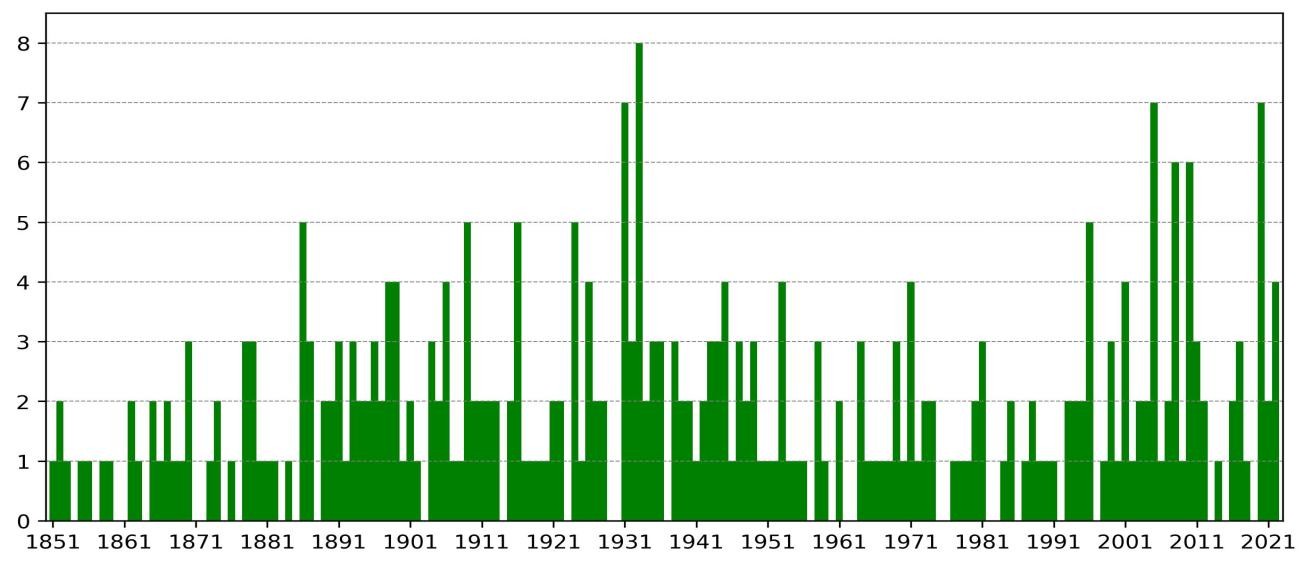Variations and trends of the tropical cyclone activity over the Caribbean Sea
Main Article Content
Abstract
An analysis of the variations and trends of tropical cyclogenesis over the Caribbean Sea between the years and is presented. The frequency of formation was analyzed for the extemporaneous months and for each month of the hurricane season, in addition to the trends described by the chronological series and the possibility of existence of at least one change point. A particular emphasis was placed on those organisms formed in the Atlantic that directly affected Cuba. Tropical cyclogenesis in the Caribbean Sea occurs mostly between June and October with marked interannual variability. Throughout the cyclonic seasons studied, tropical cyclones developed with hurricanes, of them with Categories , or . On average, tropical cyclones form over the Caribbean Sea each season, with a standard deviation of . The maximum frequency of formation occurred in October, followed by August and September. Since , an increasing trend was evident, especially from August to October, where of the cases were concentrated, with a change point towards , slightly shifted for high intensity hurricanes.
Downloads
Article Details

This work is licensed under a Creative Commons Attribution-NonCommercial 4.0 International License.
Those authors who have publications with this journal accept the following terms of the License Attribution-NonCommercial 4.0 International (CC BY-NC 4.0):
You are free to:
- Share — copy and redistribute the material in any medium or format
- Adapt — remix, transform, and build upon the material
The licensor cannot revoke these freedoms as long as you follow the license terms.
Under the following terms:
- Attribution — You must give appropriate credit, provide a link to the license, and indicate if changes were made. You may do so in any reasonable manner, but not in any way that suggests the licensor endorses you or your use.
- NonCommercial — You may not use the material for commercial purposes.
- No additional restrictions — You may not apply legal terms or technological measures that legally restrict others from doing anything the license permits.
The journal is not responsible for the opinions and concepts expressed in the works, they are the sole responsibility of the authors. The Editor, with the assistance of the Editorial Committee, reserves the right to suggest or request advisable or necessary modifications. They are accepted to publish original scientific papers, research results of interest that have not been published or sent to another journal for the same purpose.
The mention of trademarks of equipment, instruments or specific materials is for identification purposes, and there is no promotional commitment in relation to them, neither by the authors nor by the publisher.
References
Ballester, M.; González, C. & Pérez, R. 1995. Variabilidad de la ciclogénesis tropical en el Atlántico Norte. Informe Final del Proyecto “Variabilidad de la actividad ciclónica en la región del Atlántico Norte y su pronóstico”. La Habana, Cuba: Instituto de Meteorología, 88 p.
Ballester, M.; González, C. & Pérez, R. 2004. Actividad ciclónica en las áreas del Océano Atlántico, golfo de México, mar Caribe y Cuba durante el periodo 1886-2002. Informe Científico del Proyecto “Pronóstico de la actividad ciclónica en la región del Atlántico Norte, con énfasis en el Caribe y Cuba”. La Habana, Cuba: Instituto de Meteorología, 31 p.
Ballester, M.; Pérez, R. & González, C. 2005. Los huracanes del Caribe y Cuba. XI Congreso Latinoamericano e Ibérico de Meteorología y XV Congreso Mexicano de Meteorología. Memorias. Cancún Quintana Roo, México.
Ballester, M.; González, C. & Pérez, R. 2009. Actividad ciclónica en las áreas del océano Atlántico, golfo de México, mar Caribe y Cuba durante el periodo 1886-2008. Informe de Resultado del Proyecto “Variabilidad de la actividad ciclónica en la región del Atlántico Norte y su pronóstico”. La Habana, Cuba: Instituto de Meteorología, 35 p.
Ballester, M.; González, C. & Pérez, R. 2010. Variabilidad de la actividad ciclónica en la región del Atlántico Norte y su pronóstico. La Habana, Cuba: Editorial Academia, 170 p. ISBN: 978-959-270-175-5.
Chang, E.K.M. & Guo, Y. 2007. Is the number of North Atlantic tropical cyclones significantly underestimated prior to the availability of satellite observations? Geophysical Research Letters, 34 (14): 1-5. DOI: 10.1029/2007GL030169.
Kossin, P.; Olander, T.L. & Knapp, K.R. 2013. Trend Analysis with a New Global Record of Tropical Cyclone Intensity. Journal of Climate, 26 (24): 9960-9976. DOI: 10.1175/JCLI-D-13-00262.1.
Landsea, C.; Franklin, J. & Beven, J. 2015. The revised Atlantic hurricane database (HURDAT2). National Hurricane Center.
Limia, M.; Vega, R.; Pérez, R. & Durán, J. 2000. Climatología de los ciclones tropicales que han afectado a Cuba (1799-1998). Informe de Resultado No. 4 del Proyecto 01301094. La Habana, Cuba: Instituto de Meteorología, 36 p.
Palacios, J. & Ballester, M. 2009. Variabilidad en la frecuencia de los huracanes del Caribe en octubre durante el periodo 1951-2005. Revista Cubana de Meteorología, 15 (1): 73-81. La Habana, Cuba.
Sneyers, R. 1990. Technical Note No 143 On the statistical analysis of series of observations. WMO No415, Geneva, Switzerland: World Meteorological Organization, 192 p. ISBN: 978-92-63-10415-1.
Valderá, N.; González, C. & Pérez, R. 2021. Variabilidad de la actividad ciclónica tropical en el océano Atlántico, golfo de México, mar Caribe y Cuba. Revista Cubana de Meteorología, 27 (4): 1-8.
Vecchi, G.A. & Knutson, T.R. 2008. On estimates of historical North Atlantic tropical cyclone activity. Journal of Climate, 21 (14): 3580-3600. DOI: 10.1175/2008JCLI2178.1.

